固体发酵综述及其优点共70页文档
3固态发酵
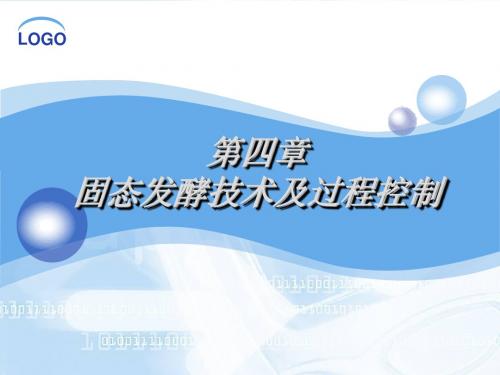
固态发酵(solid state fermentation):没有或几乎没有自有水存在 下,在有一定湿度的水不溶性固体基质中,一种或多种微生物的一个生 物反应过程。
醋生产车间
酱油生产
传统汾酒酿酒车间
世界最大"纯粮固态发酵酿酒车间
高青县城的山东扳倒井集团第九 纯 粮固态发酵酿酒生产车间
木质素酶固态发酵
(2)宏观传质过程:
① ② ③ ④ 空气进入和传出生物反应器的过程。 在没有强制通风的情况下,随着空气流动而发生的自然对流、 扩散过程等。 在生物反应器壁内与周围环境之间在发生的传质过程。 搅拌过程中的剪切效果。
好氧微生物固态发酵中氧传递:
(1)气体与固体培养基颗粒间的传质 (2)颗粒内氧的扩散
(3)氧气从气相主体到微生物的传递过程
空气阀门
加热器 排气口
紫外灯管
加湿器
空气循环
水
进气口
发酵罐
发酵罐
空气调节阀门
湿度传感器
空气温度传感器 温度控制 排气阀
加热器
曲室 排气管 旋转机 卸料旋杆机 空气调节器 装料机 调节阀
多孔板
空气过滤器
控制台
鼓风机
2、动态固态发酵反应器
1 转 鼓 式
接种和喷水口 搅拌桨电机
搅拌架电机
温度传感器
2、界面作用
(1)营养物在界面上的富集 (2)界面分布的微生物 (3)微生物界面效应的意义
3、固态机制中丝状微生物的生长(顶端延长) 4、固态机制中细菌和酵母的生长
酵母
枯草芽孢杆菌
二、固态发酵基质原料
1、固态发酵基质原料种类 未处理的农副产品或废弃物。 2、固态发酵基质原料影响微生物生长的因素 (1)固态基质的大分子结构 (2)颗粒大小影响微生物的生长
固态发酵技术-物质和热量

04
04
固态发酵技术的优化与改进
固态发酵技术的工艺优化
优化菌种选育
01
通过选育具有优良发酵性能的菌种,提高固态发酵产物的产量
和质量。
优化固态发酵工艺参数
02
通过调整发酵温度、湿度、pH值等工艺参数,改善固态发酵过
程的物质传递和热量平衡,提高产物产量。
优化固态发酵原料配比
03
微生物的生长和代谢
微生物生长
固态发酵过程中,微生物利用原料中 的营养物质进行生长繁殖,形成菌丝 体和孢子。
微生物代谢
微生物在生长过程中进行代谢活动, 将原料中的营养物质转化为代谢产物, 如酒精、乳酸、醋酸等。
代谢产物的形成和积累
酒精的形成和积累
固态发酵过程中,微生物将葡萄糖代谢产生酒精,随着发酵过程 的进行产生不利影响, 因此需要控制适宜的温度范围。
热量对固态发酵过程的影响
01
适宜的温度可以促进固态发酵的 进行,提高发酵效率。
02
过高的温度会导致微生物死亡或 失活,影响发酵效果。
温度的波动会影响固态发酵的稳 定性,因此需要保持温度的恒定 。
03
热量管理是固态发酵过程中的重 要环节,合理的热量控制可以提
固态发酵技术可以用于将 废弃物转化为生物质能, 提高能源利用效率。
在环境保护和治理领域的应用前景
有机废弃物处理
固态发酵技术可用于处理有机废弃物,如农作物秸秆、畜禽粪便 等,实现废弃物的资源化利用。
污水处理
固态发酵技术可以用于污水处理,降低水体中的有害物质含量, 提高水质。
土壤修复
固态发酵技术可以用于土壤修复,改善土壤质量,提高土壤肥力。
固态发酵技术的应用领域
固体发酵法
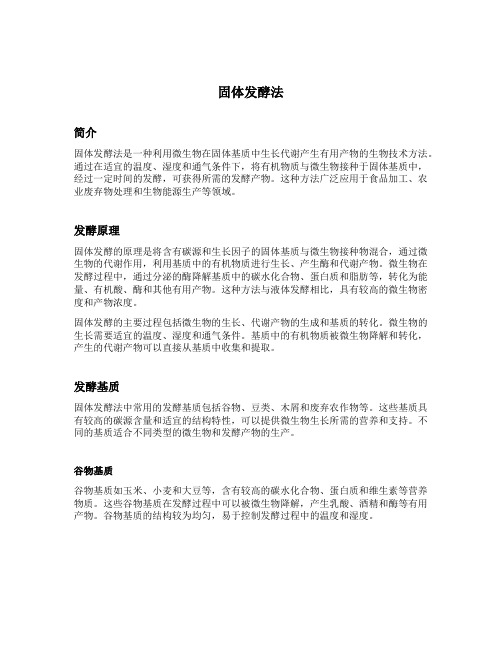
固体发酵法简介固体发酵法是一种利用微生物在固体基质中生长代谢产生有用产物的生物技术方法。
通过在适宜的温度、湿度和通气条件下,将有机物质与微生物接种于固体基质中,经过一定时间的发酵,可获得所需的发酵产物。
这种方法广泛应用于食品加工、农业废弃物处理和生物能源生产等领域。
发酵原理固体发酵的原理是将含有碳源和生长因子的固体基质与微生物接种物混合,通过微生物的代谢作用,利用基质中的有机物质进行生长、产生酶和代谢产物。
微生物在发酵过程中,通过分泌的酶降解基质中的碳水化合物、蛋白质和脂肪等,转化为能量、有机酸、酶和其他有用产物。
这种方法与液体发酵相比,具有较高的微生物密度和产物浓度。
固体发酵的主要过程包括微生物的生长、代谢产物的生成和基质的转化。
微生物的生长需要适宜的温度、湿度和通气条件。
基质中的有机物质被微生物降解和转化,产生的代谢产物可以直接从基质中收集和提取。
发酵基质固体发酵法中常用的发酵基质包括谷物、豆类、木屑和废弃农作物等。
这些基质具有较高的碳源含量和适宜的结构特性,可以提供微生物生长所需的营养和支持。
不同的基质适合不同类型的微生物和发酵产物的生产。
谷物基质谷物基质如玉米、小麦和大豆等,含有较高的碳水化合物、蛋白质和维生素等营养物质。
这些谷物基质在发酵过程中可以被微生物降解,产生乳酸、酒精和酶等有用产物。
谷物基质的结构较为均匀,易于控制发酵过程中的温度和湿度。
豆类基质豆类基质如豆饼、大豆渣等,含有丰富的蛋白质、纤维素和抗氧化物质。
这些基质在发酵过程中可以被微生物降解,产生氨基酸、酶和其他发酵产物。
豆类基质的结构较为复杂,需要在发酵过程中加入适量的水分和调节pH值。
木屑基质木屑基质如锯末、稻壳等,含有丰富的纤维素和木质素。
这些基质在发酵过程中可以被微生物降解,产生纤维素酶、木质素降解酶和其他有机酸。
木屑基质的结构较为松散,需要较高的通气条件和适量的水分来保证微生物的生长活性。
废弃农作物基质废弃农作物基质如秸秆、麸皮等,含有丰富的纤维素和半纤维素。
固液发酵
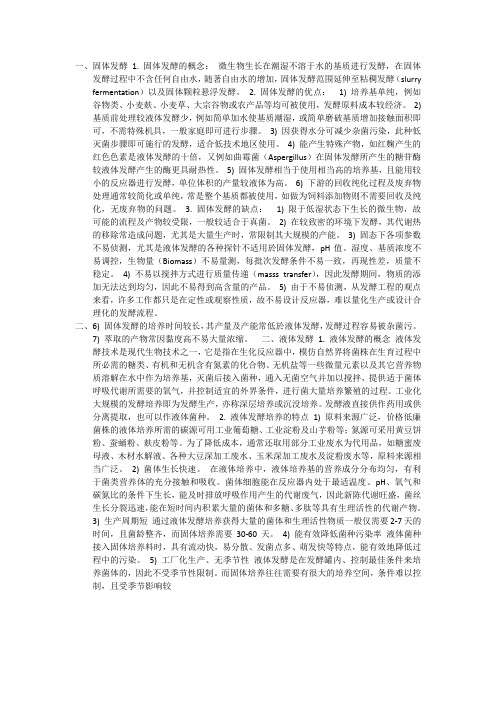
一、固体发酵 1. 固体发酵的概念:微生物生长在潮湿不溶于水的基质进行发酵,在固体发酵过程中不含任何自由水,随著自由水的增加,固体发酵范围延伸至粘稠发酵(slurry fermentation)以及固体颗粒悬浮发酵。
2. 固体发酵的优点:1) 培养基单纯,例如谷物类、小麦麸、小麦草、大宗谷物或农产品等均可被使用,发酵原料成本较经济。
2) 基质前处理较液体发酵少,例如简单加水使基质潮湿,或简单磨破基质增加接触面积即可,不需特殊机具,一般家庭即可进行步骤。
3) 因获得水分可减少杂菌污染,此种低灭菌步骤即可施行的发酵,适合低技术地区使用。
4) 能产生特殊产物,如红麴产生的红色色素是液体发酵的十倍,又例如曲霉菌(Aspergillus)在固体发酵所产生的糖苷酶较液体发酵产生的酶更具耐热性。
5) 固体发酵相当于使用相当高的培养基,且能用较小的反应器进行发酵,单位体积的产量较液体为高。
6) 下游的回收纯化过程及废弃物处理通常较简化或单纯,常是整个基质都被使用,如做为饲料添加物则不需要回收及纯化,无废弃物的问题。
3. 固体发酵的缺点:1) 限于低湿状态下生长的微生物,故可能的流程及产物较受限,一般较适合于真菌。
2) 在较致密的环境下发酵,其代谢热的移除常造成问题,尤其是大量生产时,常限制其大规模的产能。
3) 固态下各项参数不易侦测,尤其是液体发酵的各种探针不适用於固体发酵,pH值、湿度、基质浓度不易调控,生物量(Biomass)不易量测,每批次发酵条件不易一致,再现性差,质量不稳定。
4) 不易以搅拌方式进行质量传递(masss transfer),因此发酵期间,物质的添加无法达到均匀,因此不易得到高含量的产品。
5) 由于不易侦测,从发酵工程的观点来看,许多工作都只是在定性或观察性质,故不易设计反应器,难以量化生产或设计合理化的发酵流程。
二、6) 固体发酵的培养时间较长,其产量及产能常低於液体发酵,发酵过程容易被杂菌污。
固态发酵

冬季要求水温在40℃,春秋季在30~35℃,夏季时室
温即可,水温不宜低于25℃;浸曲时间:冬季2~3d, 春秋季1d,夏季6~12h 即可;浸曲后外观标准:曲 粒浮起,表面有小气泡(发酵现象),略有轻微酒气。
糖化:糖化的目的是促使糯米淀粉转化为糖分,以利 于发酵。
黄酒酵母的活化:将酵母在38~40℃,含糖2%, 酵母用量10倍以上的水溶液中复水活化,30~60 min后即可添加使用。时间不宜过长,否则酵母易 老化。
红曲
传统上:以大米为原料,接种红曲菌经固态发酵 而成的红曲米。 广义上:以红曲菌为菌种,发酵(固态、液态发 酵)而制成的各类产品的总称。 红曲固态发酵具有能耗低、培养基简单、生产过 程节水、操作简单易行、提取成本低等优点。另 外,采用固态发酵工艺无废水废渣产生,不会造 成二次污染
红曲作用
底物
化学方法:酸、碱进行化学水解
固体发酵基质原料 影响微生物生长的因素
(1)固体基质的大分子结构
(2)颗粒大小影响微生物的生长
(3)颗粒形状
(4)颗粒的多孔性
(5)颗粒均匀性及硬度
固态发酵基质的差异性
(1)复杂的,非均一的基质结构。
(2)基质的不同批次之间的差异。
(3)发酵基质混合上的困难。
(4)微生物在基质颗粒间活力的不均匀性。
3、影响固态发酵过程的主要参数
1、湿度与水活度
2、温度与热量传递
3、通气与传质过程
4、pH值
4、固态发酵与液态发酵的比较
序 号 1 2 3 4 5 6 7 项 目 水分 营养物 接种量 产物浓 度 产率 营养扩 散 散热 固态发酵 培养基没有游离水,水是培养 基中较低的组分 微生物从湿的固态基质吸收营 养物,营养物浓度存在梯度 接种量比较大,大于10% 发酵结束时,培养基是湿物料 状态,产物浓度高 使用浓缩的培养基和较小的固 体发酵生物反应器,产率高 微生物生长受营养扩散的限制 有效去除代谢热困难,易出现 过热的问题 液态发酵 培养基中始终有游离水的流动,水 是主要组分 微生物从溶解水中吸收营养物,营 养物浓度始终不存在梯度 接种量比较小,小于10% 发酵结束时,培养基是液体状态, 产物浓度低 使用稀释的培养基和较大体积的生 物反应器,产率低 不受营养扩散问题的影响 高水含量使发酵温度控制容易,发 酵设备庞大
固态发酵课件

固态发酵 设 备
固态发酵 概 述
内 涵 特 点 分 类 反应器
固态发酵是指没有或几乎没有自由 水存在下,在有一定湿度的水不溶 性固态基质中,用一种或多种微生 物的一个生物反应过程。
固态发酵 设 备
固态发酵 概 述
内 涵 特 点 分 类 反应器
固态发酵 设 备
从生物反应过程的本质考虑,固 态发酵是以气相为连续相的生物反 应过程,与此相反,液态发酵是以 液相为连续相的生物反应过程。从 这个定义中可以充分认识固态发酵 的特点,以及与液态发酵本质的区 别。
固态发酵 设 备
固态发酵 概 述
内 涵 特 点 分 类 反应器
2.1.2温度 温度是一个重要的影响因素, 一方面微生物需要适宜的生长温度 (例如:真菌生长的最适温度为 20~30 ℃),另一方面伴随微生物 的生长,会产生生大量的热,如果 温度不及时散去,温度会影响孢子 发芽、生长和产物的产率。
固态发酵 设 备
固态发酵 概 述
内 涵 特 点 分 类 反应器
固态发酵 设 备
固态发酵 概 述
内 涵 特 点 分 类 反应器
4.1 实验室固态发酵反应器、中试固态发酵 反应器与工业级固态发酵反应器 按照固态发酵反应器所承载的固体物料多少 不同,可将固态发酵反应器分为三大类:
• 第一类是实验室固态发酵反应器 可进行 克级规模固体物料的固态发酵实验;
固态发酵 与工艺设备
固态发酵 概 述
内 涵 特 点 分 类 反应器
1、固态发酵的内涵
一般发酵工艺过程按照培养基物理 性状不同,将发酵方式分为两大 类:固态发酵和液态发酵。
固态发酵 设 备
固态发酵 概 述
内 涵 特 点 分 类 反应器
固态发酵 设 备
固态发酵工程技术的研究应用分析
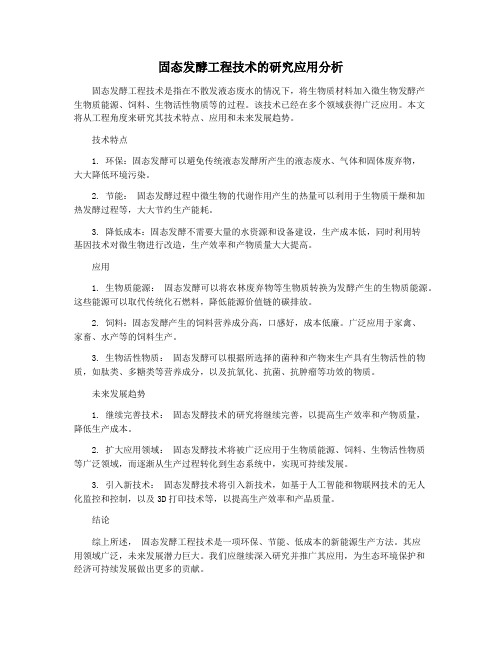
固态发酵工程技术的研究应用分析固态发酵工程技术是指在不散发液态废水的情况下,将生物质材料加入微生物发酵产生物质能源、饲料、生物活性物质等的过程。
该技术已经在多个领域获得广泛应用。
本文将从工程角度来研究其技术特点、应用和未来发展趋势。
技术特点1. 环保:固态发酵可以避免传统液态发酵所产生的液态废水、气体和固体废弃物,大大降低环境污染。
2. 节能:固态发酵过程中微生物的代谢作用产生的热量可以利用于生物质干燥和加热发酵过程等,大大节约生产能耗。
3. 降低成本:固态发酵不需要大量的水资源和设备建设,生产成本低,同时利用转基因技术对微生物进行改造,生产效率和产物质量大大提高。
应用1. 生物质能源:固态发酵可以将农林废弃物等生物质转换为发酵产生的生物质能源。
这些能源可以取代传统化石燃料,降低能源价值链的碳排放。
2. 饲料:固态发酵产生的饲料营养成分高,口感好,成本低廉。
广泛应用于家禽、家畜、水产等的饲料生产。
3. 生物活性物质:固态发酵可以根据所选择的菌种和产物来生产具有生物活性的物质,如肽类、多糖类等营养成分,以及抗氧化、抗菌、抗肿瘤等功效的物质。
未来发展趋势1. 继续完善技术:固态发酵技术的研究将继续完善,以提高生产效率和产物质量,降低生产成本。
2. 扩大应用领域:固态发酵技术将被广泛应用于生物质能源、饲料、生物活性物质等广泛领域,而逐渐从生产过程转化到生态系统中,实现可持续发展。
3. 引入新技术:固态发酵技术将引入新技术,如基于人工智能和物联网技术的无人化监控和控制,以及3D打印技术等,以提高生产效率和产品质量。
结论综上所述,固态发酵工程技术是一项环保、节能、低成本的新能源生产方法。
其应用领域广泛,未来发展潜力巨大。
我们应继续深入研究并推广其应用,为生态环境保护和经济可持续发展做出更多的贡献。
固态分层发酵的工艺流程和特点
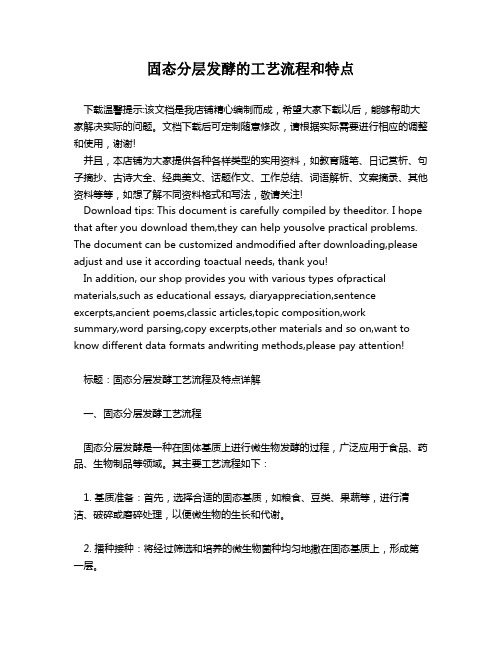
固态分层发酵的工艺流程和特点下载温馨提示:该文档是我店铺精心编制而成,希望大家下载以后,能够帮助大家解决实际的问题。
文档下载后可定制随意修改,请根据实际需要进行相应的调整和使用,谢谢!并且,本店铺为大家提供各种各样类型的实用资料,如教育随笔、日记赏析、句子摘抄、古诗大全、经典美文、话题作文、工作总结、词语解析、文案摘录、其他资料等等,如想了解不同资料格式和写法,敬请关注!Download tips: This document is carefully compiled by theeditor. I hope that after you download them,they can help yousolve practical problems. The document can be customized andmodified after downloading,please adjust and use it according toactual needs, thank you!In addition, our shop provides you with various types ofpractical materials,such as educational essays, diaryappreciation,sentence excerpts,ancient poems,classic articles,topic composition,work summary,word parsing,copy excerpts,other materials and so on,want to know different data formats andwriting methods,please pay attention!标题:固态分层发酵工艺流程及特点详解一、固态分层发酵工艺流程固态分层发酵是一种在固体基质上进行微生物发酵的过程,广泛应用于食品、药品、生物制品等领域。
固态发酵的综述
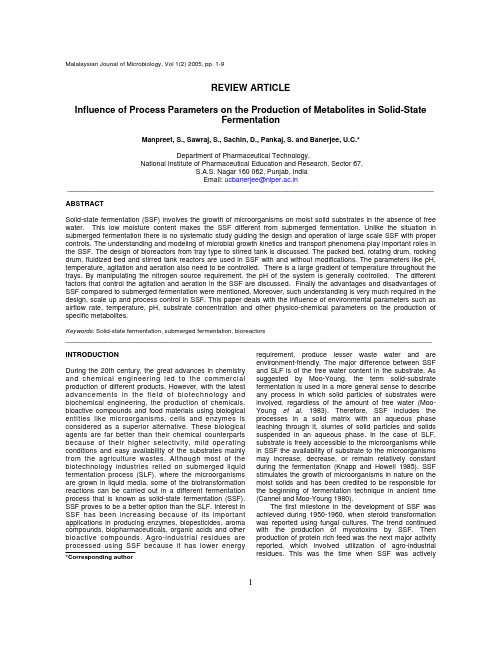
Malalaysian Jounal of Microbiology, Vol 1(2) 2005, pp. 1-91REVIEW ARTICLEInfluence of Process Parameters on the Production of Metabolites in Solid-StateFermentationManpreet, S., Sawraj, S., Sachin, D., Pankaj, S. and Banerjee, U.C.*Department of Pharmaceutical Technology,National Institute of Pharmaceutical Education and Research, Sector 67,S.A.S. Nagar 160 062, Punjab, India Email: ucbanerjee@niper.ac.in_______________________________________________________________________________________________ ABSTRACTSolid-state fermentation (SSF) involves the growth of microorganisms on moist solid substrates in the absence of free water. This low moisture content makes the SSF different from submerged fermentation. Unlike the situation in submerged fermentation there is no systematic study guiding the design and operation of large scale SSF with proper controls. The understanding and modeling of microbial growth kinetics and transport phenomena play important roles in the SSF. The design of bioreactors from tray type to stirred tank is discussed. The packed bed, rotating drum, rocking drum, fluidized bed and stirred tank reactors are used in SSF with and without modifications. The parameters like pH, temperature, agitation and aeration also need to be controlled. There is a large gradient of temperature throughout the trays. By manipulating the nitrogen source requirement, the pH of the system is generally controlled. The different factors that control the agitation and aeration in the SSF are discussed. Finally the advantages and disadvantages of SSF compared to submerged fermentation were mentioned. Moreover, such understanding is very much required in the design, scale up and process control in SSF. This paper deals with the influence of environmental parameters such as airflow rate, temperature, pH, substrate concentration and other physico-chemical parameters on the production of specific metabolites.Keywords : Solid-state fermentation, submerged fermentation, bioreactors_______________________________________________________________________________________________ INTRODUCTIONDuring the 20th century, the great advances in chemistry and chemical engineering led to the commercial production of different products. However, with the latest advancements in the field of biotechnology and biochemical engineering, the production of chemicals, bioactive compounds and food materials using biological entities like microorganisms, cells and enzymes is considered as a superior alternative. These biological agents are far better than their chemical counterparts because of their higher selectivity, mild operating conditions and easy availability of the substrates mainly from the agriculture wastes. Although most of the biotechnology industries relied on submerged liquid fermentation process (SLF), where the microorganisms are grown in liquid media, some of the biotransformation reactions can be carried out in a different fermentation process that is known as solid-state fermentation (SSF). SSF proves to be a better option than the SLF. Interest in SSF has been increasing because of its important applications in producing enzymes, biopesticides, aroma compounds, biopharmaceuticals, organic acids and other bioactive compounds. Agro-industrial residues are processed using SSF because it has lower energyrequirement, produce lesser waste water and are environment-friendly. The major difference between SSF and SLF is of the free water content in the substrate. As suggested by Moo-Young, the term solid-substrate fermentation is used in a more general sense to describe any process in which solid particles of substrates were involved, regardless of the amount of free water (Moo-Young et al. 1983). Therefore, SSF includes the processes in a solid matrix with an aqueous phase leaching through it, slurries of solid particles and solids suspended in an aqueous phase. In the case of SLF, substrate is freely accessible to the microorganisms while in SSF the availability of substrate to the microorganisms may increase, decrease, or remain relatively constant during the fermentation (Knapp and Howell 1985). SSF stimulates the growth of microorganisms in nature on the moist solids and has been credited to be responsible for the beginning of fermentation technique in ancient time (Cannel and Moo-Young 1980).The first milestone in the development of SSF was achieved during 1950-1960, when steroid transformation was reported using fungal cultures. The trend continued with the production of mycotoxins by SSF. Then production of protein rich feed was the next major activity reported, which involved utilization of agro-industrial residues. This was the time when SSF was actively*Corresponding authorMal. J. Microbiol. Vol 1(2) 2005, pp. 1-92researched, followed by numerous patents and publications on basic aspects of SSF, development of bioreactors, production of microbial products using SSF such as food and feed (Han et al., 2001), various primary and secondary metabolites, bioprocess such as bioleaching, biopulping, biobenefication, bioremediation (Classen et al., 2000) and industrial enzymes (Pandey et al., 1999). Several authors had reviewed the history and development of SSF. Aidoo et al., (1982) made an attempt to trace the history of growth of microorganisms on solid substrates and the term solid-state fermentation came after this. Cannel and Moo-Young in 1980 reviewed the developments of SSF in food industry and composting. They compared SSF with SLF and also described the advantages and disadvantages. Some differences between SSF and SLF are discussed in Table 1GENERAL ASPECTS OF SSF PROCESSThe important aspects which should be considered before starting a solid-state fermentation include the selection of suitable microorganism and substrate, optimization of process parameters and isolation and purification of the product. SSF follows the same steps as in the SLF, namely substrate preparation, inoculum preparation, cultivation within a bioreactor and finally the downstream processing and recovery of the product. Fungi and yeast seem to be the favorable one than bacteria because of their ability to grow on the substrates, which are low in water content. Due to high water activity requirement, bacterial cultures might not be suitable for SSF. However, Pandey in 1992 reported that bacterial culture can be well managed and manipulated for SSF process. It seems that the high yield in SSF as compared to SLF is due to the growth of the microorganisms similar to their natural habitat, resulting in higher metabolic activities.Another aspect that affects the production is the selection of proper substrate. Substrate in SSF is non-soluble material that acts both as physical support and source of nutrients. Byproducts of agricultural activities or the products obtained after the processing of agricultural materials can be used as substrates. Some of the substrate may require pretreatment. Chopping or grinding may be necessary to reduce particle size, cracking may be necessary to increase the accessibility of the interior of the particle to the microorganism, thermal pretreatment or even chemical hydrolysis might be necessary to increase the susceptibility of macromolecules within the solid to attack by microbial enzymes (Mitchell et al., 2000). Selection could be done by considering suitable value-addition and/or disposal of specific substrate (Moo-Young et al., 1983, Pandey el al ., 2000). The second thing one has to consider is the production of a specific product from a suitable substrate and for this, different substrates have to be screened for a specific product. Similarly, it would be important to screen different microorganisms and select the most suitable one. Product isolation could be relatively tougher and more costly when using naturally occurring raw materials such as wheat bran as the substrateSolid-state fermentation (SSF)Submerged liquid fermentation (SLF)Organisms requiring less water for growth are preferred such as filamentous fungi.Inert support (natural or artificial), containing all components for growth in the form of solution. Less chances of contamination because of low availability of water.Small size bioreactors can be used.Less consumption of energy for aeration and gas transfer.Limiting factor for growth is diffusion of nutrients. Lots of difficulties in measuring the quantity of biomass present and other online processes. Downstream processing is easy, cheaper and less time consuming.Liquid waste is not producedMedia concentration is very much lower as compared to water content.Required processed ingredients are expensive. Higher water activity becomes the major cause of contamination in SLF.Large-scale bioreactors are required because media is very much diluted.High air pressure consumes more power and there is poor transfer of gas in SLF. Vigorous mixing makes diffusion easy.Online sensors are available and sampling is easy for biomass measurement.Water makes downstream process difficult and very expensive.High quantity of liquid waste is produced, causes difficulties in dumpingTable 1: Differences between Solid-state and Submerged liquid Fermentationbecause while extracting the product after fermentation, along with the product, several other water-soluble components from the substrate also leach out and may pose difficulties in the purification process.Selection of process parameters and their optimization are other key aspects of SSF. This part includes physiochemical and biochemical parameters such as particle size, initial moisture content, initial pH, relative humidity, incubation temperature, agitation, aeration, age and size of inoculum, supplementation of nutrients and trace elements, supplementation of additional carbon source and inducers, extraction of product and its purification.MICROBIAL TYPES USED IN SSFThe low amount of free liquid in the substrate affects the whole process of SSF and therefore it becomes the most important feature of SSF. All the factors in SSF depend upon the amount of water present in the substrate. Care should be taken while selecting the microorganism for fermentation on solid-substrates. Due to the less availability of free water in SSF process than the majority of liquid fermentations, most of the SSF processes involve fungi, although there are number of reports involving bacteria and yeast. Bacteria are mainly involved in processes like composting, ensiling and yeasts have been used for ethanol and food or feed production (Doelle et al., 1992).The yeast grows on solid-substrate as minor member and the dominant species are bacteria for example Lactobacilli in ensiling and in tape manufacturing (Moo Young et al., 1983). Saccharomyces cerevisiae has been employed in semi-solid fermentation of grape pomace and for SSF of sweet sorghum, sugar beets (Kirby and Mardon 1980) and fodder beets (Gibbons et al.,1984, Kargi and Curme 1985). A number of bacterial species have been employed for solid-substrate fermentation using many substrates. Lactobacilli are used for ensilage and thermophilic bacteria predominate in composting. Bacillus subtilis is the major organism used for production of Japanese food Natto (Beuchat et al., 1985). Lactobacillus plantarum and Propionibacterium shermanii are used to ferment and preserve high moisture grain (Flores et al., 1985).Out of all the groups of fungi, the filamentous fungi are the major group of microorganisms, which predominate in the SSF process. Different species of fungi used in SSF process include many species of Aspergillus, Rhizopus,Alternaria, Fusarium, Monilia, Mucor, Trichoderma and some species of Penicillium. Most of the species belong to filamentous fungi, as these are best suited because of their ability to spread over and to penetrate inside the solid-substrate. The other advantage of using filamentous fungi is that the fungal mycelia synthesize and release large quantity of extra-cellular hydrolytic enzymes.SUBSTRATES USED IN SSFSubstrates used in SSF are generally insoluble in water.In practice, water is absorbed onto the substrate particles, which can then be used by microorganisms for growth and metabolic activities. Bacteria and yeast grow on the surface of the substrate while fungal mycelium penetrates into the particles of the substrates (Pandey, 1992).Substrate for SSF can be divided into three groups, starchy substrates, cellulose or lignocellulose and those with soluble sugar. Example of starchy substrate includes rice, cassava, wheat bran, rice bran, buckwheat seeds, corn meal, and sweet potato residue and banana meal.Lignocellulosic solid-substrate includes wheat straw, corn, rice stover, wheat bran, sugar-beet pulp and wood.Substrates containing soluble sugars include grape pomace, sweet sorghum, sugar-beet, pineapple waste, carob pods and coffee pulp. Another strategy is to impregnate inert solid material such as bagasse or hemp with soluble sugars in order to provide a SSF environment for the growth (Weber et al., 1999).Natural substrates are easily available and are cheaper than synthetic substrates. But, they generally require pretreatment to make their chemical constituents more accessible and their physical structure more susceptible to mycelial penetration. Physical treatment includes chopping or grinding to reduce size and cracking to make the interior of the particle more accessible.Chemical treatment includes high temperature cooking and acid or alkali treatment. Supplementation of additional nutrients may be required in order to stimulate growth, induce enzyme synthesis or to prolong secondary metabolite production such as the supplementation of0.5% of glucose or cellobiose, 0.5% peptone, asparagineor yeast extract are in use. Many references can be cited where synthetic substrates have also been used for the growth of microbes such as synthetic polymers or substances like agar and gelatin which provide homogeneous solid-substrate (Georgiou and Shuler 1986). Gelatin and kappa-carrageenan have also been used. However, these substrates are not exploited commercially because of their high cost and low availability. The use of these substrates is restricted for research purpose only.Physical factors affecting utilization of solid-substrate include accessibility of substrate to the microbes (porosity and particle sizes affect the accessible surface area to the organisms), film effect and mass effect. The size of substrate particles affects the extent and rate of microbial colonization, air penetration, CO2 removal and downstream extraction. The optimum particle size often represents a compromise between the accessibility of nutrients and the availability of oxygen. Particle size from1 mm to1cm is often used in SSF. Knapp and Howell(1985) reviewed the effect of alteration of substrate particle size on SSF. Pandey (1992) has reported that productivities were higher with the substrate that contains particles of mixed sizes varying from 180 m to 1.4 mm.Chemical factors affecting utilization of solid-substrate includes degree of polymerization and crystallinity. The3selection of substrates and optimization of its concentration plays an important role in yielding the higher growth rates of microbes. At higher growth rate, the ratio between heat losses to heat production is low and therefore helps to approach the behavior of large scale bioreactor.TEMPERATUREMicrobial growth in SSF generates significant amount of metabolic heat. It has been reported that 100-300 kJ of heat per kg of cell mass is generated in a SSF process (Prior et al., 1992). Establishment of temperature gradients and localized overheating of the substrate occurs because of inefficient removal of heat from the substrate. Heat transfer problem in SSF includes temperature gradients that may cause belated microbial activity, dehydration of the medium and undesirable metabolic deviations (Rathbun and Shuler 1983, Saucedo-Castaneda et al., 1990). Heterogeneous materials make heat removal difficult; this is due to low transfer coefficient and low thermal conductivity (Narahara 1984). Temperature can rise rapidly, because there is little water to absorb the heat or in other words mean specific heat capacity of the fermenting mass is much lower than that of water. Therefore, heat generated must be dissipated immediately as most of the microorganisms used in SSF are mesophilic, having optimal temperature for growth between 20 and 40o C and maximum growth below 50ºC.Different methods are used for dissipation of heat such as cooling of metal trays using circulating coolant and intermittent agitation. Other methods include forced aeration, water circulation through a jacket surrounding the fermenter, agitation of the solids and covering the external surface of fermenter with water soaked burlaps. However, forced aeration is generally the technique of choice for heat removal. This has been reported that most of the heat generated (up to 80%) in the SSF process is removed by using forced aeration. Heat generation rates indicate that conduction heat transfer was the least efficient mechanism (8.65%) when compared with convective (26.65%) and evaporative (64.7%) mechanism (Barstow et al., 1988).Effect of temperature on both specific growth rate and specific death rate has been well described by Arrhenius type of equation (Szewezyk and Myszka 1994).m = moexp (-E g/RT) - k do exp (-E d/RT)Where R is universal gas constant, T is the absolute temperature, E g and E d are the activation energies for growth and death and mo and k do are specific growth rate and specific death rate, respectively.The deleterious effect of high temperature on spore germination, cell growth, product formation, sporulation and consequently on the overall productivity of the fermentation process are well described by Moreaux (Moreaux, 1980). A temperature of 47°C at the centre of the fermentating substrate in tempeh production, 67°C ina rectangular fermenter with an 80 mm bed depth and 60-70°C in the centre of a composting bed have been reported (Rathbun and Shuler 1983, Hayes 1977). Peak heat generation rates in Koji processes lies in the range 71-159 kJ/Kg.h but average rates are more moderate, at 25-67kJ/Kg.h. An increase of about 2-5°C in the temperature of the solids in a fermenter of 40 mm depth resulted in a doubling of the fermentation time required to attain similar enzyme titer to those in the temperature gradient free fermenter of 20 mm depth.EFFECT OF pH AND ITS CONTROLThere are remarkable changes, which occur in the pH of the substrates. These are mainly for the production of acids due to incomplete oxidation of the substrate or uptake of ammonium ions, which will cause the pH to fall, while the release of ammonia by deamination of urea, or other amines will increase the pH. As we cannot monitor pH in the SSF it is very difficult to control the pH. So, it is desirable to use microorganisms which can grow over a wide range of pH and which have broad pH optima. By using different ratios of ammonium salts and urea in the substrate, pH control in both natural and model SSF system can be obtained (Raimbault and Alazard 1980).The effect of increasing buffer concentration, effect of pH on the maximum specific growth rate and the optimization of different buffers for the growth and enzyme parameter were investigated by Nagel et al., (1999). They have also calculated the required buffer concentration by utilizing expected biomass production, initial pH and pH change. Exact control of pH is very difficult in SSF process, but one can maintain pH during the process by using pH-correcting solutions (Mitchell et al., 1991). Many substrates are effective buffers. This is particularly true for protein rich substrate, especially if deamination of protein is minimal. Model has been proposed which relate growth rate to pH based on empherical equations describing experimental data for the effect of pH on growth (Muck et al., 1991, Pitt, 1993).WATER ACTIVITYWater activity (a w) of the moist solid substrate is the ratio of vapour pressure of water above the substrate in a closed system to the vapour pressure of the pure water at same temperature. It is measured as relative humidity divided by 100. Pure water has a w = 1.00 and a w decrease with the addition of solutes. Bacteria mainly grow at highera w values, while filamentous fungi and some yeasts cangrow at lower a w value (0.6-0.7). The microorganisms, which can grow and are capable of carrying out their metabolic activities at lower a w values, are good for SSF processes. For fungi, the optimal moisture requirement varies between 40 and 80% (w/w), but for the same organism growing on different substrate, the optimum moisture level may differ widely, hence, the amount of moisture by itself is unreliable for predicting growth (Prior et al., 1992). The fermentation process itself leads to a4change in a w as products are formed and the substrate is hydrolyzed. Excessive moisture tends to aggregate thesubstrate particle and hence aeration is made difficult. Water activity also affects product formation and the spectrum of product produced and characteristics such as aroma are also affected by water activity. Since the water activity depends on the concentration of dissolved solutes, salts, sugars or other solutes can be added to alter the activity. The optimal a w also depends on the factors such as agitation rate and cultivation temperature. During fermentation a w is calculated by aeration with humidified air and sometimes by intermittent water spray. It has been shown that in the course of fungal growth in SSF, higher water activities favour sporulation while low water activities favour spore generation or mycelia growth. Gervais (Gervais et al., 1988) studied the influence of a w on enzyme biosynthesis and enzyme activities produced by fungi and developed a new sensor which allowed continuous a w measurement of submerged and SSF. A kinetic model, which relates the rate constant of death of the microbial cells to water activity and temperature, has been proposed by Moser in 1988. Prosser in 1982 reported that the width of the peripheral growth zone of the colonies is constant despite variation in water activity and radial extension rate is directly proportional to the specific growth rate.APPLICATIONS OF SSFFrom centuries human beings have been producing their food by employing different microorganisms but they did not know the theory behind it. It is the case with SSF, it was a traditional process, but the exact potential of SSF was only known during 21st century. The traditional Koji process may be considered the archetype of SSF started in 7th century in Japan. Its importance is because of the high content of amylolytic and proteolytic enzymes, which catalyze the degradation of starches and proteins. Koji production is done using strains of Aspergillus oryzae on steamed rice and incubated under controlled temperature and humidity. A Japanese biochemist and industrialist leader Dr Jokichi Takamine began commercial production of koji from the fungus Aspergillus oryzae and called it "takadiastase" introduced koji in USA in the year 1891 using wheat bran. Most of the cheese such as blue-veined cheese using Penicillium roqueforti, Camembert and Brie cheese using Penicillium camemberti and Penicillium caseicolum, are produced by SSF (Mial, 1975). SSF is also widely employed in processes like ensiling, composting using thermophilic bacteria, mesophiles, actinomycetes and fungi (Stentiford and Dodds 1992). Nowadays, lots of byproducts such as enzymes, organic acids, ethanol, biogas, antibiotics, surfactants, toxins, bioremediation agents, mushrooms, compost, microbial polysaccharides, biopesticides, protein-enriched fermented foods, predigested feeds for ruminants are produced by SSF process. The different applications of SSF are given in Table 2 and Table 3.COMPOUND (FUNCTION) SOURCE SUBSTRATE REFERENCE PharmaceuticalsGibberellic acid(Plant growth harmone)Fusarium moniliforme Sugarcane bagasse (Tomasini et al., 1997)Zearalenone (Growth promoter) Fusarium moniliforme Corn (Balakrishnan and Pandey 1996) Bacterial endotoxin (Insecticide) Bacillus thuringensis Coconut waste (Balakrishnan and Pandey 1996) Ergot alkaloids (Migrane) Cleviceps purpurea, C. fusiformis Sugarcane bagasse (Hernandez et al., 1993. Penicillin (Antibiotic) Penicillium chrysogenum Sugarcane bagasse (Balakrishnan and Pandey 1996) Cephalosporin (Antibiotic) Cephalosporium armonium Barley (Balakrishnan and Pandey 1996 Cephamycin C (Antibiotic) Streptomyces clamuligerus Wheat rawa with cottonseedcake and sunflower cake(Kota and Sridhar 1999)Tetracycline (Antibiotic) S. viridifaciers Sweet potato residue (Balakrishnan and Pandey 1996) Chlortetracycline (Antibiotic) S. viridifaciers Sweet potato residue (Balakrishnan and Pandey 1996) Oxytetracycline (Antibiotic) S. rimosus Corn cob (Yang and Swei 1996) Acitinorhodin Methylenomycin(Antibiotic)S. coelicolor Agar medium (Balakrishnan and Pandey 1996) Surfactin (Antibiotic) Bacillus subtilis Soyabean residue, okara (Balakrishnan and Pandey 1996) Cyclosporin A(Immuno suppressive drug)Tolypocladium inflautum Wheat bran (Sekar and Balaraman 1998)Clavulanic acid [- lactamase inhibitor (antibacterial)]S. clavulingerus Wheat rawa with soy flour andsunflower cake(Sircar et al., 1998) Table 2: Application of SSF in the production of pharmaceuticals5Mal. J. Microbiol. Vol 1(2) 2005, pp. 1-96PRODUCT OR PROCESS ORGANISMSUBSTRATEREFERENCEEnzymes Glucoamylase Aspergillus sp. Tea waste, rice bran, wheat bran. (Selvakumar et al., 1998) (Arasaratnam et al., 1997) Lipase Aspergillus niger, Candida rugosa,Penicillium restrictum. Gingelly oil cake, coconut cake, babassu oil cake,(Kamini et al. 1998)(Benjamin and Pandey 1997) (Gombert et al., 1999) Cellulases Bacillus sutilis, Aspergillus sp.,Banana fruit stalk wastes, soyabean meal,(Krishna 1999)(Gutierrez et al., 1999) Pectinases Talaromyces flavus, Aspergillus nigerCitrus wastes, soy bran and wheat bran, apple pectin.(Crotti et al., 1999) (Castilho et al., 2000)(Berovic and Ostroversnikj 1997) Inulinase Staphylococcus sp. Or Kluyveromyces marxianus Wheat bran, rice bran, coconut oil cake and corn flour.(Selvakumar and Pandey 1999) XylanasesAspergillus tamari,Trichoderma longibrachiatum, Trichoderma reesei, A. niger, Bacillus sp.Corn cob, wheat bran, sugar-cane bagasse, soymeal, wheat bran.(Ferrreira et al. 1999)(Gutierrez and Tengerdy 1998) (Gessesse and Memo 1999)Biopesticides Bioinsecticide Coniothyrium minitansImpregnated hemp(Weber et al., 1999) Bioremediation Phanerochaete chrysosporium, Lentinula edodes Sugarcane bagasse pith, pentachlorophenol in soil (Rodriguez et al., 1999) (Okeke et al., 1997) BiofilterVariousPeat + volatile organics(Wu et al., 1998)Food and Feed A. sojaeCaffine removal Aspergillus tamarii Impregnated sugarcane bagasse (Hakil et al., 1999) Delignification White rot fungi Wheat straw(Dorado et al., 1999) Improved nutrition Penicilium sp.Bergamot fruit peel(Scerra et al., 1999)Protein enrichment Neurospora sitophilaSugar beet pulp or citrus waste(Shojaosadati et al., 1999)Aroma substances Aroma compounds Bjerkandera adusta Wheat bran (Lapadatescu and Bonnarme 1999)PyrazinesBacillus subtilisGround soybeans(Larroche et al., 1999)Organic compounds Citric acid Aspergillus nigerDry coffee husk, sweet potato, carob pod, pineapple waste, corncobs. (Roukas 1999) (Tran et al., 1998)(Hang and Woodams 1998) Kojic acid Aspergillus oryzaeSteamed rice(Mial 1975)Ethanol Saccharomyces cerevisiaeSweet potato or sweet sorghum(Sree et al., 1999)Polymers Succinoglycan Agrobacterium tumefaciens, Rhizobium hedysaris. Spent malt grain or ivory nutshaving or grated carrots,impregnated spent malt grains(Stredansky and Conti 1999a) (Stredansky and Conti 1999b) Xanthan gumXanthomonas campestris.Spent malt grains, citrus peels, apple pomace, or grape pomace, Impregnated spent malt grains.(Stredansky et al., 1999b])Table 3: Other applications of SSF。
固态发酵工艺ppt资料

pH值
• pH 值也是影响微生物生长代谢的关键因素之一。但固态发酵中某些 物料的优良缓冲性能有助于减少对pH 控制的需要。一般认为,只要调 节好初始pH值,发酵过程中不必对其进行监测和控制。所以固态发酵 时,只要把初始pH 调到所需要的值,发酵过程通常不用检测和控制pH。 在实际过程中,菌体代谢会导致物料pH值发生较大变化。
气态环境和氧气传递
• 氧的传递,主要指需氧的固态发酵而言。由于微生物的生长,在固体表 面形成菌膜并使基质结块,基质被代谢而变粘,因而随着微生物的生长, 可能造成基质内局部区域缺氧而影响生长。另外基质的高含水量或使 用较细的基质料,也会影响基质内氧的传递。为了防止基质内缺氧和 增加基质内氧的浓度,促进微生物生长,通常采用通风、搅拌或翻动来 增大氧的传递。通风是最常用和有效的方法,除可以增加氧的传递,还 有利于热交换。翻动或搅拌虽可防止物料结块,并且利于热交换,但过 分的翻动或搅拌影响菌体与基质的接触,并可能损伤菌丝体,使水分蒸 发过多而使物料变干,抑制菌体生长。生产中可将以上2 种方式结合 起来使用。此外增加氧传递的常用方式还有: (1) 采用较薄的基质 层;(2) 使用多孔的、较粗的利于氧传递的疏松性材料作基质填充料, 如稻壳等; (3) 使用带孔的培养盘; (4) 采用低含水量的物料,中间补水。
固态发酵技术的研究
目录
1
什么是固态发酵
2
工艺控制参数
3
固态发酵的应用
4
1 固态发酵
❖ 固态发酵是一种培养基呈固态、培养基中没有或几乎没有自由流动水、 利用自然底物作为碳源和能源或利用惰性底物作为支持物的发酵过 程 ,它也是人们利用微生物生产所需产品的悠久技术之一。1945年青 霉素的大规模工业化生产,开创了液体深层发酵技术及现代发酵工业。 但现代发酵工业的首要条件是纯种培养,而固态发酵作为发酵工业中 的比较古老落后工艺的代表,一直未能得到更好的发展和利用。但自 20世纪70年代以来,随着世界性能源危机的出现和环境保护意识的增 强,固体发酵的技术又重新受到重视。
固态发酵简介

单菌固态纯种发酵是在纯培养基础上建立
起来的,对于选育良种、保持生理活性和代谢过
程中的稳定起很大作用。它对于扩大固态发酵的 应用范围和潜力的发挥起到非常重要作用,同
时,也是固态发酵一个重要方向。
根据固态发酵固相的性质,可以把固态发酵
分为两种类型。一种是以农作物(如麸皮、豆饼
别离人心伤,伤心人断肠,断肠人嗜酒。酒过愁肠人更愁
响,国内外逐步重视对固态发酵的研究开发,已
取得了很大进展。现代固态发酵是为了充分发挥
固态发酵的优势,针对传统固态发酵存在的问 题,使之适应现代生物技术的发展而进行的,可
以实现限定微生物的纯种大规模培养。当然这里
不可不提的就是发酵罐,它在其中起的作用是不
可小视的。
别离人心伤,伤心人断肠,断肠人嗜酒。酒过愁肠人更愁
与固体底物基质固态发酵相比,惰性载体吸
附固态发酵还具有其他很多优点,如:能够对培
养基营养成分进行合适的调节;容易了解产物中 的各成分并进行分析,从而有利于发酵过程的控
制以及动力学研究与模型建立等。
2df0f9c9h 凤凰平台代理1
等)为底物的固态发酵方式。这些底物既是固态
发酵过程中的固相组成部分,又为微生物生长提
供营养,在这里可以称这种发酵为传统固态发酵 方式(或固体底ห้องสมุดไป่ตู้基质固态发酵)。另一种固态发
酵方式是以惰性固态载体为固态发酵过程令的
固相,微生物生长的营养是吸附在载体上的培养
液,称这种发酵方式为惰性载体吸附固态发酵。
别离人心伤,伤心人断肠,断肠人嗜酒。酒过愁肠人更愁
固态发酵可以以许多不同的形式进行,按照
使用的微生物的情况和形成的产品条件不同,固
态发酵可分为自然富集固态发酵、强化微生物混 合固态发酵、限定微生物混合固态发酵和单菌固
第十六章固态发酵

第一页,编辑于星期五:十九点 八分。
第一节 概述
第二节 固态发酵的分类 第三节 固态发酵反应器
第四节 固态发酵的应用
第五节 固态发酵发展趋势和应用前景
第六节 固态发酵的典型实例—白酒
第二页,编辑于星期五:十九点 八分。
第一节 概述
一、固态发酵的内涵 一般发酵工艺过程按照培养基物理性状不同,将发酵方式
单菌固态纯种发酵是在纯培养基础上建立起来的,对于 选育良种、保持生理活性和代谢过程中的稳定起很大作 用。
第十三页,编辑于星期五:十九点 八分。
2. 按固态发酵固相的性质分类
(1)同体底物基质固态发酵利用的培养基是既充当固 相,又为微生物生长提供营养的初级农作物产物。
如麸皮、马铃薯、谷子、豆饼以及其他含淀粉和纤 维素的农作物产品。
是主要组分
2
营养物
微生物从湿的固态基质吸收营养 微生物从溶解水中吸收营养物,营
物,营养物浓度存在梯度
养物浓度始终不存在梯度
3 接种量
接种量比较大,大于10%
接种量比较小,小于10%
4
产物浓 发酵结束时,培养基是湿物料状 发酵结束时,培养基是液体状态,
度 态,产物浓度高
产物浓度低
5
产率
使用浓缩的培养基和较小的固体 使用稀释的培养基和较大体积的生
(2)固态发酵采用的固体是惰性载体,载体可以是天 然的,也可以是人工分成的。 载体材料有大麻、珍珠岩、聚氨酯泡沫体、蔗糖渣和 聚苯乙烯等。
back
第十四页,编辑于星期五:十九点 八分。
第三节 固态发酵反应器
不同形式的工业规模的固态发酵反应器:
转鼓式、木盒式、加盖盘式、垂直培养盒式、倾斜接种盒 式、浅盘式、传送带式、圆柱式、混合式
固态发酵技术

固态发酵技术嘿,朋友们!今天咱来聊聊固态发酵技术呀!这固态发酵啊,就像是一场微生物的盛大派对!想象一下,那些小小的微生物们在固态的基质上欢快地蹦跶、生长、繁衍,是不是特别有意思?咱先说这固态发酵的好处吧,那可真是不少嘞!它能让产品有着独特的风味,就好比咱中国人做菜,那独特的味道就是靠着各种调料和独特的烹饪方法出来的。
固态发酵也是这样,能给产品带来别样的魅力,这魅力可不是随随便便就能有的哦!而且啊,固态发酵相对来说还比较节能环保呢!不像有些技术,得消耗大量的能源和资源。
它就像是一个会过日子的巧媳妇,总能用最少的资源做出最好的成果。
你说这固态发酵是不是很神奇?它就像一个隐藏的宝藏,等待着我们去发掘和利用。
再看看那些利用固态发酵技术生产出来的东西,比如酒。
好酒可都是靠固态发酵得来的呀!那醇厚的口感,那迷人的香气,啧啧,喝上一口,简直让人陶醉其中。
还有那些传统的发酵食品,不都是固态发酵的杰作嘛!在实际操作中,固态发酵也有它的讲究呢。
就跟咱做饭一样,盐放多了咸,放少了没味。
固态发酵也是,温度、湿度、基质的选择等等,都得把握得恰到好处。
这可需要经验和技巧啦,可不是随随便便就能搞定的。
要是温度太高了,那些微生物可能就热得受不了,“哎呀,太热啦,我可不干啦!”;要是湿度不合适,它们又会抱怨“太干啦太湿啦,没法好好工作啦!”所以啊,得像照顾宝贝一样照顾好这些微生物,让它们舒舒服服地工作。
咱中国人不是常说嘛,慢工出细活。
固态发酵也是这样,不能着急,得给它足够的时间让微生物们慢慢发挥。
心急可吃不了热豆腐哦!总之呢,固态发酵技术就像是我们生活中的一个小惊喜,它能给我们带来那么多美好的东西。
我们要好好利用它,让它为我们的生活增添更多的精彩!难道不是吗?让我们一起为固态发酵技术点赞吧!。
固态发酵的概述

当前发酵财产所利用的主如果深层液态发酵,虽
然这类手艺已颠末端较持久的利用和研究,可
是一直陪着她走那阴暗的岁月,她曾经想要追随父亲而去天堂的念想
是,它仍然存在着良多灾以降服的错误谬误,需 要采取新的手艺加以解决。
1ck0f7c7d 发酵罐/
义难以反应出固态发酵的科学内涵。从生物反应 过程的本质考虑,固态发酵是以气相为持续相的 生物反应过程,与此相反,液态发酵是以液相为
持续相的生物反应过程。从这个定义中可以充分
熟谙固态发酵的特点.和液态发酵本质的辨别
是一直陪着她走那阴暗的岁月,她曾经想要追随父亲而去天堂的念想
(图 1.1)。 2、固态发酵的特点
料上培养微生物的工艺过程。而对固态发酵来
讲,是指没有或几近没有自由水存鄙人,在有必
是一直陪着她走那阴暗的岁月,她曾经想要追随父亲而去天堂的念想
然湿度的水不溶性固态基质中,用一种或多种微 生物的一个生物反应过程。 因为人们对固态发酵传统的熟谙是从固体
基质开端,它既是微生物发展代谢的碳源能源,
又是微生物发展的微环境,上述对固态发酵的定
固态发酵是气体作为生物反应过程中的 O2、
CO2、热量、营养和产品的传递介质,表示为 O2、
CO2 分散比较等闲,热量传递坚苦,存在较着的 营养梯度,并且无大年夜量有机废水产生。 3、固态发酵与液态发酵比较阐发 固态发酵与液态发酵本质辨别是以气相仍
是一直陪着她走那阴暗Biblioteka 岁月,她曾经想要追随父亲而去天堂的念想
1、固态发酵的内涵
是一直陪着她走那阴暗的岁月,她曾经想要追随父亲而去天堂的念想
一般发酵工艺过程遵循培养基物理性状不 合,将发酵编制分为两大年夜类:固态发酵和液 态发酵。液态发酵首要有概况发酵和深层发酵
- 1、下载文档前请自行甄别文档内容的完整性,平台不提供额外的编辑、内容补充、找答案等附加服务。
- 2、"仅部分预览"的文档,不可在线预览部分如存在完整性等问题,可反馈申请退款(可完整预览的文档不适用该条件!)。
- 3、如文档侵犯您的权益,请联系客服反馈,我们会尽快为您处理(人工客服工作时间:9:00-18:30)。
56、书不仅是生活,而且是现在、过 去和未 来文化 生活的 源泉。 ——库 法耶夫 57、生命不可能有两次,但许多人连一 次也不 善于度 过。— —吕凯 特 58、问渠哪得清如许,为有源头活水来 。—— 朱熹 59、我的努力求学没有得到别的好处, 只不过 是愈来 愈发觉 自己的 无知。 ——笛 卡儿
拉
60、生活的道路一旦选定,就要勇敢地 走到底 ,决不 回头。 ——左
固体发酵综述及其优点
1、纪律是管理关系的形式。——阿法 纳西耶 夫 2、改革如果不讲纪律,就难以成功。
3、道德行为训练,不是通过语言影响 ,而是 让儿童 练习良ห้องสมุดไป่ตู้好道德 行为, 克服懒 惰、轻 率、不 守纪律 、颓废 等不良 行为。 4、学校没有纪律便如磨房里没有水。 ——夸 美纽斯
5、教导儿童服从真理、服从集体,养 成儿童 自觉的 纪律性 ,这是 儿童道 德教育 最重要 的部分 。—— 陈鹤琴
